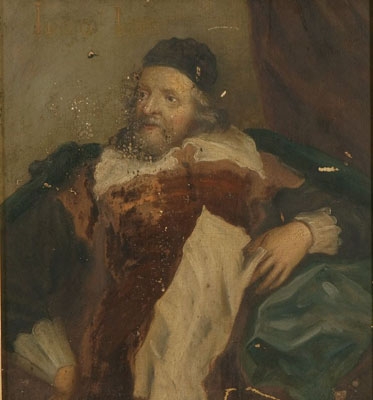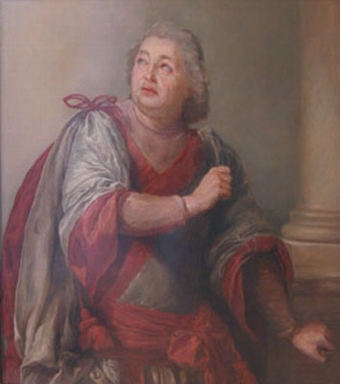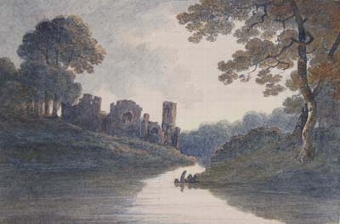portrait of inigo jones 1573 -1652
- View other items in:
- antiques interior design modern and vintage
- other interior design
artware ltd
Enquire about this antique
Artware Ltd has 565 antiques for sale.
click here to see them all
After an engraving by Robert Van Voerst, after Sir Anthony Van Dyck drawimg in the Chatsworth collection.
Inigo Jones (July 15, 1573 ? June 21, 1652) is regarded as the first significant British architect of the modern period, and the first to bring Italianate Renaissance architecture to England. He also made valuable contributions to stage design.Beyond the fact that he was born in the vicinity of Smithfield in central London, the son of a Welsh Catholic cloth worker, and christened at the church of St Bartholomew the Less, little is known about Jones'' early years. He certainly travelled abroad at the end of the century, probably at the expense of a patron, and was very influenced by the work of the Italian architect Andrea Palladio. In the early 1600s, Jones was employed by the wife of King James I, Queen Anne, to provide costumes and settings for a masque at court, something he continued to do even after he started receiving architectural commissions. His first-known building was the New Exchange in the Strand in London, designed in 1608 for the Earl of Salisbury. In 1611 Jones was appointed surveyor of works to Henry, Prince of Wales but the young prince died in 1612. In 1613, Jones left England to visit Italy again. A year after his return, he was appointed surveyor to the king, a position he held until 1643.
But towards the end of the 16th century, he became one of the first Englishmen to study architecture in Italy, making two visits to that country. The first (c.1598-1603) was possibly funded by Roger Manners, 5th Earl of Rutland. The second, from 1613 to 1614, found Inigo in the company of the Earl of Arundel. He may also have been in Italy in 1606 and was influenced by the ambassador Henry Wotton and owned a copy of Andrea Palladio''s works with marginalia that refer to Wotton. See Wotton And His Worlds 2004 by Gerald Curzon. His work became particularly influenced by Palladio. To a lesser extent, he also held that the setting out of buildings should be guided by principles first described by ancient Roman writer Vitruvius.
The Queen''s House at Greenwich Jones'' best known buildings are the Queen''s House at Greenwich, London (started in 1616, his earliest surviving work) and the Banqueting House at Whitehall (1619) ? part of a major modernisation by him of the Palace of Whitehall ? which also has a ceiling painted by Peter Paul Rubens. The Banqueting House was one of several projects where Jones worked with his personal assistant and nephew by marriage John Webb. It was begun in 1617 but work was suspended at her death in 1619 and only completed in 1635. In 1619 the old Banqueting House at Whitehall Palace burned down and Jones began work on a new one. It was completed in 1622 and in 1635, an allegorical painting for its ceiling was commissioned from Rubens. Jones also worked on the restoration of St Paul''s Cathedral, adding a magnificent portico to the west end (the whole cathedral was lost in the Great Fire of London). The other project in which Jones was involved was the design of Covent Garden. He was commissioned by the Earl of Bedford to build a residential square along the lines of an Italian piazza. The Earl felt obliged to provide a church and he warned Jones that he wanted to economise. He told him to simply erect a "barn" and Jones'' oft-quoted response was that his lordship would have "the finest barn in Europe". Little remains of the original church situated to the west of the piazza. A masque Costume for a Knight, designed by Inigo Jones.As well as his architectural work, Jones did a great deal of work in the field of stage design. He is credited with introducing movable scenery and the proscenium arch to English theatre. Jones designed costumes, sets, and stage effects for a number of masques by Ben Jonson, and the two had famous arguments about whether stage design or literature was more important in theatre. (Jonson ridiculed Jones in a series of his works, written over a span of two decades.)
As the Surveyor of Works to King Charles I, Jones worked for Queen Henrietta Maria on the design of a Roman Catholic chapel at Somerset House (an act that provoked great suspicion from the Protestants) and his career effectively ended with the outbreak of the English Civil War in 1642 and the seizure of the King''s houses in 1643. In 1645, he was at the siege and burning by Parliamentarian forces of Basing House in Hampshire. His property was later returned to him (c.1646) but Jones ended his days living in Somerset House and was subsequently buried in the Church of St Benet Paul''s Wharf, in London. John Denham and then Christopher Wren followed him as King''s Surveyor of Works. It was in his capacity as surveyor that he was asked to conduct some measurements of Stonehenge. While some of Jones''s observations are questionable, and his interpretations and conclusions can only be regarded as fanciful at best, his was the first serious survey. He was an influence on a number of 18th century architects, notably Lord Burlington and William Kent.
Antiques.co.uk Ref: 7BHN4XEP
- Materials:
- Oil on Canvas
- Width (cm):
- 11.81 x 10.63 cm 30.00 x 27.00 ins
Artware Ltd
Artware Fine Art specialises in fine antique, decorative and historical portraits and topographical pictures . We cover a period from the 17th and 18th centuries through to the 19th & 20th Centuries. We have over 150 portraits in stock, which can be viewed on our web site, each historical portrait has well researched biographical information both on the sitter and the artist.
Contact details
18 La gare
51 Surrey row
London
Greater London
SE1 0BZ
UNITED KINGDOM
T: 0207 921 97904
E: greg@artwarefineart.com
W: www.artwarefineart.com














